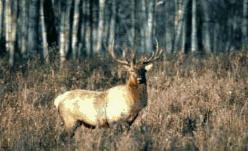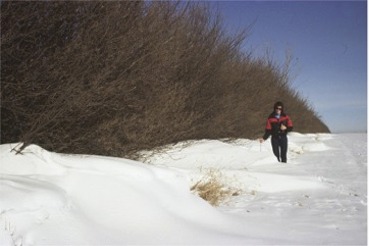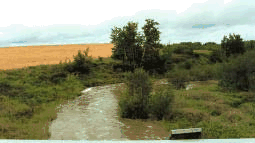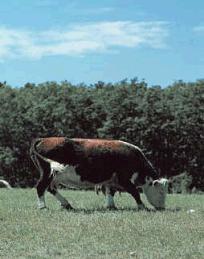| | What are greenhouse gases? | What is agroforestry? | Emission removals, reductions and agroforestry | Summary
What are Greenhouse Gases?
Greenhouse gases (GHG) are found in the atmosphere. They trap the sun's heat and warm the earth's climate. The main GHG emissions from the agriculture sector are nitrous oxide (N2O), methane (CH4) and carbon dioxide (CO2). The Majority of scientists agree that increasing levels of GHG caused by fossil fuel combustion, land use changes and agricultural and industrial activities, contribute to changes in temperature, precipitation, and weather patterns.
Agroforestry is one way to remove CO2 emissions from the atmosphere through carbon sequestration and reduce CO2 emissions by using wood as an alternative energy source.
What is Agroforestry?
Agroforestry is the practice of growing trees and agricultural products on the same area at the same time. Agroforestry helps farmers create more integrated, diverse, productive, profitable, healthy and sustainable land-use systems. It also provides environmental, economic and social benefits to landowners and/or producers.
Agroforestry practices sequester carbon. Trees, like growing crops, remove CO2 from the air, storing it as carbon in trunks, branches, leaves and roots. Carbon can also be stored in soils and peatlands. Agroforestry practices such as woodlots, planting shelterbelts, maintaining forested riparian buffers and silvipasture, have the potential to sequester carbon for many decades.
Agroforestry practices that are suitable for Alberta include:
- Woodlot Management
- Shelterbelts
- Silvipasture
- Forest Riparian Buffers
- Intercropping
Woodlot management
Woodlots are privately owned forested land. Woodlots are approximately 4% of Alberta’s forested land. Carbon is sequestered by both hard and soft wood species and is directly proportional to the rate of growth and size of the mature tree or shrub. Products from woodlots, such as lumber, furniture, paper and other building materials are forms of carbon sequestration.

Trees on open pasture
Practices that make woodlots a source of CO2 are deforestation, mismanagement, and conversion of forested land to agriculture. When forests are cleared and slash burned, carbon stored in trees is emitted into the atmosphere as CO2. Unlike wildfires or harvesting in the Boreal forest, woodlots are not regenerated. Deforestation clears the land of trees for a long period of time and the land is converted to other uses that have lower carbon sequestration potential.
Elimination of deforestation, changing and adapting harvest methods, and controlling fire, insect and diseases outbreaks conserves carbon in forest vegetation and soil. To maximize the quantity of carbon sequestered per unit of land area, the greatest opportunity for carbon sequestration is when deforested lands are reforested or afforested.
Afforestation is the planting of trees on historically non-forested land. Afforestation may be an alternative land use in areas where crop productivity is low, or where cropping has reduced nutrient and organic carbon levels. If soil erosion is a problem or degraded land needs to be rehabilitated, then afforestation is a good option.
Other activities that maximize carbon sequestration are to extend rotation cycles, improve tree growth, reduce damage to remaining trees, reduce logging waste, implement soil conservation practices, and maintain forests as mature or old growth ecosystems.
Shelterbelts
Properly planned field shelterbelts trap snow, reduce evapotranspiration, provide wildlife habitat and protect adjacent soil and crops from wind. Researchers from Saskatchewan, Manitoba, North and South Dakota concluded that wheat yields increased an average of 3.5% on fields sheltered by mature shelterbelts. This includes land taken out of production for shelterbelt planting and competition of the shelterbelt with the crop.

Shelterbelts trap snow
A dense five-row shelterbelt planted around farm buildings lowers winter heating costs between 18-25%. Farmstead shelterbelts also lower the cost of snow removal, provide shelter for livestock, lower winter feeding costs, and improve on-farm water use efficiency by providing effective wind and snow control.
Silvipasture
Silvipasture is the planting of trees on open pasture. It is designed and managed for tree production, tree products, forage and livestock. Silvipasture is different than forest grazing in Alberta, which refers to grazing on natural forest areas. Trees provide shade and shelter for livestock during extreme weather conditions. Trees can also be managed for high-value sawlogs and other timber products. With careful management, silvipasture can be successful and productive.
Forested riparian buffers
Riparian areas are the green zone along rivers, streams and wetlands. Trees grow rapidly in riparian zones because of favorable moisture and nutrient conditions. Forest buffers help protect rivers, streams and wetlands, and improve water quality by:
- catching eroded soil and preventing sedimentation,
- filtering nutrient runoff,
- protecting and enhancing the stream environment, and
- buffering against floods and droughts.
Riparian buffer areas offer a low-cost method to control non-point source pollution (pollution carried by runoff from large areas of land such as construction sites, cities and agricultural fields). In addition, trees and shrubs provide essential wildlife habitat.
Intercropping
Intercropping is the growing of agriculture crops among rows of trees. The primary consideration for establishing this system is to understand interactions between trees and agricultural crops. Intercropping in Alberta is most feasible with hybrid poplar and barley or wheat.

Creek riparian area
Emission Removals, Reductions and Agroforestry
If Canada implements emissions trading as part of the domestic response to global climate change, farmers may be able to increase revenue by growing trees and selling their emission removal credits into this system (see Bulletin #7 of this series). The Prairie Farm Rehabilitation Administration (PFRA) concluded that mature coniferous shelterbelts store up to 80 tonnes carbon per kilometer and deciduous shelterbelts store up to 118 tonnes carbonper kilometer (Table 1). However, in absence of a formal emission trading system, it is still premature to accurately determine what the carbon credit value could be.
The growing market demand for fiber to meet the needs of the pulp and paper industry has caused forest companies to look at hybrid poplar to sequester carbon. Hybrid poplar sequesters more carbon per year than other tree species (Table 2), because of its rapid growth characteristics. However, a hybrid poplar is short lived and harvested over shorter rotations than other species (12-15 years for hybrid poplar verses 40 years for spruce). Once harvested, trees no longer sequester carbon but can become a source of stored carbon (i.e. lumber and wood products), or a source of CO2 emissions into the atmosphere if used for bioenergy or left to decompose.
Table 1: Carbon (C) stored in coniferous and deciduous trees in shelterbelts*
| Species | Total C kg per tree | Tonnes C per km |
| White Spruce | 180 | 80 |
| Scots Pine | 113 | 63 |
| Colorado Spruce | 148 | 82 |
| Green Ash | 125 | 63 |
| Manitoba Maple | 117 | 59 |
| Hybrid Poplar | 295 | 118 |
| Siberian Elm | 145 | 73 |
| *assumes a 0.4:1 root to top ratio |
Table 2: Average carbon (C) sequestration rates for prairie species grown in plantations.
| Species | Carbon Sequestration Rate (tonnes C per hectare per year) |
| Aspen, Green Ash | 1.5 |
| White Spruce | 0.5 |
| Hybrid Poplar | 5.0 |
Farmers approached by companies or proactively interested in selling credits as a source of revenue generation should be aware of the state of the carbon credit market and the risks involved. Economic risks associated with short-term cash flow and return on investment over the longer-term hybrid poplar rotation requires prudent analysis by the landowner. Further, rules for monitoring, measuring and verifying carbon sequestration projects still need to be developed.
Trees and wood waste are also being used as alternative fuels (bioenergy). Biomass from trees is suitable to produce heat, power and transportation fuels. Bioenergy technologies reduce GHG emissions by reducing the use of non-renewable resources. Net CO2 emissions from a unit of electricity generation from bioenergy are 10 to 20 times lower than from fossil fuel based electricity generation.
Other CO2 emission reductions from agroforestry practices result from reduced heating requirements for farmsteads, reduced fuel, fertilizer and machinery costs compared to conventional inputs of annual crop production, and less snow removal.

Cow Grazing with shelterbelt in background
Summary
Agroforestry practices such as woodlots, afforestation, shelterbelts, silvipasture, and forested riparian buffers in agriculture operations can reduce and remove CO2 emissions from the atmosphere. Having access to cost effective emission reduction and removal opportunities will help minimize the overall economic impacts of any domestic or international emissions constraint. Reducing emissions can improve the agricultural industry's production efficiencies, conserve soil and water resources, and contribute to international efforts to slow global warming.
Sources
Kort, J.,& R. Turnock, “Annua C Accumulation in Agroforestry Plantations”, AFIF, 1998.
Sinks Table Options Report. 1999. Land-use, land-use change and forestry in Canada and the Kyoto Protocol. National Climate Change process, 169 pp.
To order more copies of this bulletin, contact Conservation and Development Branch, Alberta Agriculture, Food and Rural Development at (780) 422-4385. |
|